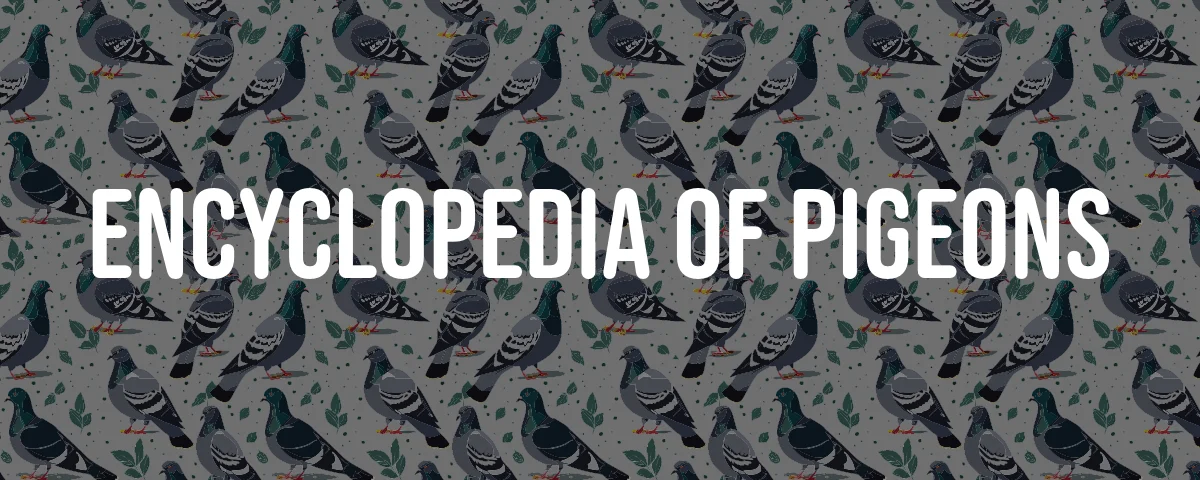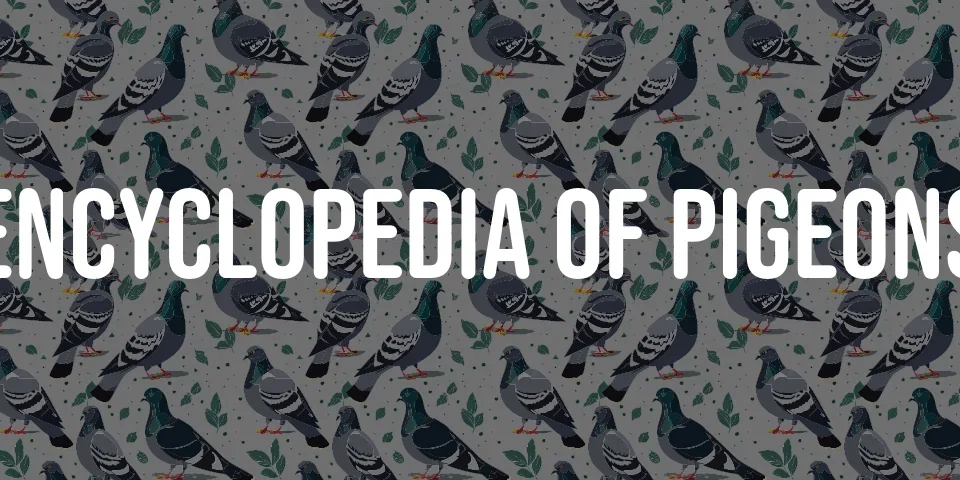Introduction to the Dutch Cropper
If you ever wander through an old Dutch market square, you might spot a peculiar, grand pigeon strutting about with all the regal composure of a monarch—this, my friend, could very well be the Dutch Cropper. Few breeds in the pigeon world can boast such longevity; the Dutch Cropper’s history weaves back to the 1500s, when Rembrandt was still in diapers and tulips had yet to cause economic chaos. Despite their imposing stature and vivacious spirit, these birds have the gentlest souls—calm as monks, sociable as bartenders during happy hour. It’s this contrast, this blend of size and serenity, that has won over fanciers from Amsterdam to Adelaide.
Belonging to the so-called “blower” Cropper family, the Dutch Cropper is a heavyweight contender in both muscle and tradition. For centuries, these pigeons have been at the heart of Dutch and Belgian breeding passion—a living feathered relic, if you will, still celebrated by new generations entranced by its peculiar charm.
Historical Background and Origin
Picture the 16th-century Low Countries: windmills, canals, and, yes, fancy pigeons. The Dutch Cropper’s story begins in this landscape, with records from the 1600s waxing poetic about “great Croppers with muffs.” The mystery of its true origin lingers—was it a happy accident of crossbreeding, or a deliberate act by a visionary breeder in Holland or Belgium? Either way, these birds were pivotal in shaping the art (and obsession) of pigeon fancier culture in the region.
After the Second World War, when Europe was busy rebuilding its cities and its spirit, a handful of devoted breeders embarked on a mission: to restore the Dutch Cropper’s original splendor. They pored over old standards, scoured the countryside for surviving bloodlines, and doggedly selected for those classic traits—size, carriage, and the unmistakable Cropper personality. The result? A breed that still resonates with echoes of its storied past, its legacy firmly etched in the annals of Dutch aviculture.
Role in Post-War Breeding Efforts
The devastation of war left more than just physical scars; it threatened to erase entire living traditions. Enter the post-war pigeon fanciers—part scientists, part sentimentalists—who rolled up their sleeves to rescue the Dutch Cropper from the brink. Their solution? Cross Dutch Croppers with their Ghent cousins, carefully blending lineages in hopes of recapturing what time and conflict had scattered.
- they zeroed in on restoring heft and stature,
- obsessed over achieving that textbook posture,
- wouldn’t settle for anything less than the breed’s legendary composure.
Of course, genetics sometimes threw a curveball—unexpected feather patterns, quirky postures, birds with more personality than sense. These surprises didn’t deter the breeders; if anything, they added a dash of unpredictability that made the pursuit all the more intriguing. In a world desperate for continuity, the Dutch Cropper’s renaissance was a small, feathery act of defiance.
Relation to Other Cropper Breeds
If the Dutch Cropper were a character in a family drama, it would undoubtedly be the showy, charismatic cousin—closely related to the Holle Cropper and the Uploper, but possessing a personality all its own. The Holle, with its rotund build, is the compact muscle of the family, while the Uploper stands tall and proud, the upright sibling who never slouches at family reunions.
- the Holle Cropper: stout, round, almost cartoonish in its proportions,
- the Uploper: a master of poise, with a posture that would put a ballerina to shame,
- each breed, though sharing roots in the Dutch landscape, took its own evolutionary detours, shaped by breeders’ whims and regional tastes.
Their similarities are a testament to shared heritage, but their differences make the Cropper clan a delightfully diverse bunch.
Characteristics of the Dutch Cropper
Imagine a pigeon that’s all grandeur and balance: the Dutch Cropper stands broad and deep, its body nearly parallel to the earth, as if daring gravity to challenge its equilibrium. That long, elegant neck supports a crop so impressively globular, it could almost double as a crystal ball—if you’re into that sort of thing.
The eyes? A fiery orange-red, glowing with mischief, regardless of whether the feathers are stark white or dressed in midnight black. The plumage itself is nothing short of luxurious—thick, plush, and accented by extravagant feathering on the feet, those “muffs” that lend an air of aristocracy. Despite its bulk, the Dutch Cropper is all about spherical harmony, a walking (or rather, strutting) lesson in avian geometry.
Physical Attributes
Once you’ve seen a Dutch Cropper, it’s impossible to mistake it for anything else—broad as a sumo wrestler, deep-chested like an opera singer, and with a backline as smooth as a freshly zambonied ice rink. The iconic globe-shaped crop is the centerpiece, but the whole package—the low, stable stance; the legs perfectly tucked beneath—screams robustness and poise.
Their feet are extravagantly feathered, those signature muffs like Victorian spats for birds. Even in a crowd of fancy breeds, the Dutch Cropper looks like it’s got somewhere important to be. Yet none of that grandeur comes at the expense of balance; every feature, from the curve of the neck to the density of the plumage, is in careful proportion, a nod to the breed’s refined standards.
Temperament and Behavior
You might expect a bird of this size and flair to be a diva—hardly! The Dutch Cropper has a temperament that would make a golden retriever jealous. Friendly, unflappable, and curious, they’ll quickly cozy up to patient caretakers, and are equally content mingling with their feathered peers.
- they adapt to chaos or calm with equal aplomb,
- thrive in bustling lofts or quiet backyard setups,
- require little more than basic care and a bit of attention to thrive.
For beginners, they’re a dream. For seasoned fanciers, a reliable companion. Their sociability is legendary; forget pigeonholes—these birds break the mold.
Unique Features
Let’s get straight to it: the Dutch Cropper’s crowning glory is that massive, balloon-like crop, puffed up with pride and confidence. Coupled with their horizontal carriage, this creates a silhouette you won’t soon forget—part sports car, part snow globe.
The heavy muffs give a touch of high fashion, while their color palette runs the gamut from subtle to show-stopping. Those orange-red eyes? Like hot coals peeking from a snowy drift. The breed’s sheer presence—its size, its bearing, its self-assurance—ensures that even in the cacophony of a show hall, the Dutch Cropper commands attention.
Breeding Standards and Practices
Breeding a Dutch Cropper isn’t for the faint of heart or the slapdash hobbyist. The standards are exacting: the ideal bird is broad, deep, nearly horizontal, neck elegantly elongated, crop full and perfectly round. Feathered feet—those glorious muffs—are non-negotiable, and the backline should flow as smoothly as a jazz solo.
Selective breeding isn’t just about chasing perfection; it’s about correcting the little quirks that sneak in: undersized frames, awkward posture, skimpy muffs. Every pairing is a calculated risk, a balancing act between tradition and innovation, with the aim of preserving the breed’s timeless appeal.
Selective Breeding Techniques
Breeders are equal parts artist and scientist. Their goal? Enhance the breed’s signature features—bulk, poise, amiability—without sacrificing genetic health. There’s a fine art to choosing pairs: some birds are broad but lack muffs, others have grand crops but need a little more backbone (literally and figuratively).
- matchmaking often focuses on complementing strengths and shoring up weaknesses,
- while always keeping an eye on genetic diversity—no one wants a pigeon version of a royal inbred,
- breeders monitor offspring with the intensity of stage parents, tweaking their strategy as needed.
Sometimes, the results are dazzling; other times, they’re a reminder that nature has a wicked sense of humor.
Breeding Standards and Expectations
Imagine a checklist that would give even the most diligent accountant a headache—such is the scrutiny Dutch Croppers face. The ultimate bird needs:
- a body as wide and deep as a soup bowl,
- a neck that stretches gracefully, cradling that iconic crop,
- a back as smooth as a jazz sax,
- legs directly beneath for that unmistakable stability.
Plumage is the cherry on top—lush, vibrant, and crowned with muffs thick enough to make a Victorian dandy jealous. Only by holding fast to these standards can breeders ensure that the Dutch Cropper continues to impress, generation after generation.
Common Faults in Appearance
Not every bird is born a champion. Sometimes a Dutch Cropper emerges with a frame more svelte than robust, or stands so upright you’d think it was auditioning for a modern dance troupe. Bare feet (the horror!), wings that don’t meet neatly over the back, or plumage that looks like it’s been through the wash one too many times—these flaws can keep a would-be winner on the sidelines.
No breeder relishes culling, but maintaining the breed’s integrity means making tough calls. After all, a Dutch Cropper without its trademark features is like a windmill without sails—still Dutch, but missing the point.
Color Varieties and Markings
Color aficionados, rejoice! The Dutch Cropper is a veritable parade of hues—crisp whites, velvety blacks, sun-bright yellows, and every shade in between. But why stop at solids? These birds boast barred patterns worthy of a Mondrian painting—blue-black, blue-silver, and more. Then there are the pied beauties, splashed with bold patches of black, red, or yellow, and the tiger-marked varieties, speckled like a starry Dutch night.
- beyond the visual fireworks, these color patterns are a badge of breeding prowess,
- a testament to the patience and eye for detail that defines the best fanciers.
Standard Pigeon Colors
Among the classics, the deep blues and inky blacks stand out, their richness a magnet for judges and enthusiasts alike. Pied birds, with their dramatic color blocks, steal the show at exhibitions. These shades aren’t mere aesthetics—they’re tradition incarnate, echoing the preferences of breeders from centuries past.
Body Marks and Patterns
Body markings tell a story, each barred wing or pied patch a chapter in the Dutch Cropper’s ongoing saga. The most coveted patterns are precise—blue-black bars like twin brushstrokes, pied splashes arranged with almost painterly care. Tiger speckles add a wild-card element, a reminder that even the most refined breeds are just a little bit untamable.
Breeders pore over these details, striving for a balance between beauty and authenticity. In a way, each bird’s plumage is a living archive—proof of the breed’s journey through generations of careful selection and occasional serendipity.
Major Faults in Coloration
Alas, not every Dutch Cropper is a masterpiece. Uneven tones, muddy colors, or off-standard patterns can mar an otherwise promising bird. Such flaws are more than a matter of taste—they can sideline a pigeon from show rings and diminish its value as a breeder. The fix? Relentless selection and a refusal to compromise on color purity.
Exhibition and Pigeon Fanciers
Step into a pigeon show and you’ll see the Dutch Cropper holding court—judges circling, cameras flashing, onlookers whispering. Here, size matters, as does posture and, above all, that unmistakable crop. Shows aren’t just pageants; they’re battlegrounds where reputations are made and lost.
More importantly, these gatherings are where fanciers connect—swapping tips, debating standards, and sometimes, just admiring the spectacle. The Dutch Cropper’s prestige is built on this communal celebration, a shared commitment to the breed’s enduring allure.
Participation in Shows and Competitions
For breeders, competition isn’t just about ribbons; it’s validation for years of meticulous work. Judges scrutinize every aspect—size, stance, globe-shaped crop—while spectators marvel. Young bird classes introduce the next generation to the breed’s quirks and charms.
Winning is sweet, but the camaraderie, the exchange of ideas, and the collective pride in keeping the Dutch Cropper’s torch burning—that’s the real prize. Each show is a chapter in the breed’s living history.
Breeders Clubs and Associations
Behind every great pigeon breed is a cadre of passionate fanciers, and the Dutch Cropper is no exception. Clubs organize shows, publish newsletters brimming with advice and gossip, and set the standards that keep breeders honest.
- they serve as matchmakers, mentors, and sometimes referees,
- offering guidance on everything from healthcare to feather care,
- fostering a genuine sense of community.
It’s this network of enthusiasts that keeps the breed vibrant, ensuring the Dutch Cropper’s legacy isn’t just preserved but enriched with each passing year.
Conservation Status and Efforts
Preserving the Dutch Cropper isn’t just about aesthetics—it’s about safeguarding genetic diversity. Breeders walk a tightrope, pairing birds carefully to avoid inbreeding while simultaneously enhancing the breed’s signature traits. Clubs champion the cause, organizing breeding programs and outreach to bring new enthusiasts into the fold.
They understand that every bird is a living link in a centuries-old chain, and that their efforts today ensure the Dutch Cropper struts on for generations yet unborn. Exhibitions, community gatherings, and a bit of good old-fashioned rivalry keep the enthusiasm—and the breed—alive.
Comparisons with Related Breeds
Line up a Dutch Cropper beside a Holle or an Uploper and you’ll see the family resemblance—size, carriage, attitude. But look closer: the Holle is the round-bodied cousin, the Uploper the upright show-off, each shaped by its own story yet bonded by a common heritage.
- Holle: round, robust, almost comically compact,
- Uploper: tall, straight-backed, the aristocrat of the trio,
- Dutch Cropper: the classic, the archetype, carrying the legacy of its homeland with every step.
The diversity within the Cropper family is a microcosm of Dutch avicultural ingenuity—a tapestry woven from shared roots and divergent dreams.
Holle Cropper and Uploper
The Holle Cropper, all curves and confidence, is like a living bowling ball—a crowd-pleaser with heft. The Uploper, by contrast, seems to channel the spirit of Dutch uprightness, all vertical lines and regal calm. All three breeds share a birthplace, but selective breeding has pushed them in unique directions, each a feathered homage to the creativity of Dutch fanciers.
Influence on the English Pouter
Cross the North Sea and you’ll find the Dutch Cropper’s influence alive and well in the English Pouter. The English borrowed a page from the Dutch playbook—adopting that signature size, the grand crop, and the dignified poise that sets these birds apart.
- the long, swan-like neck,
- the balloon-like crop,
- and the stately bearing—
these are all Dutch gifts, reimagined by English hands. The result? A cross-cultural classic, equally at home in London as it is in Leiden. In show halls and backyard lofts alike, the Dutch Cropper’s legacy lives on, a reminder that true artistry knows no borders.
And there you have it—the Dutch Cropper: part history, part spectacle, all heart. Some birds just refuse to fade quietly into the background.






